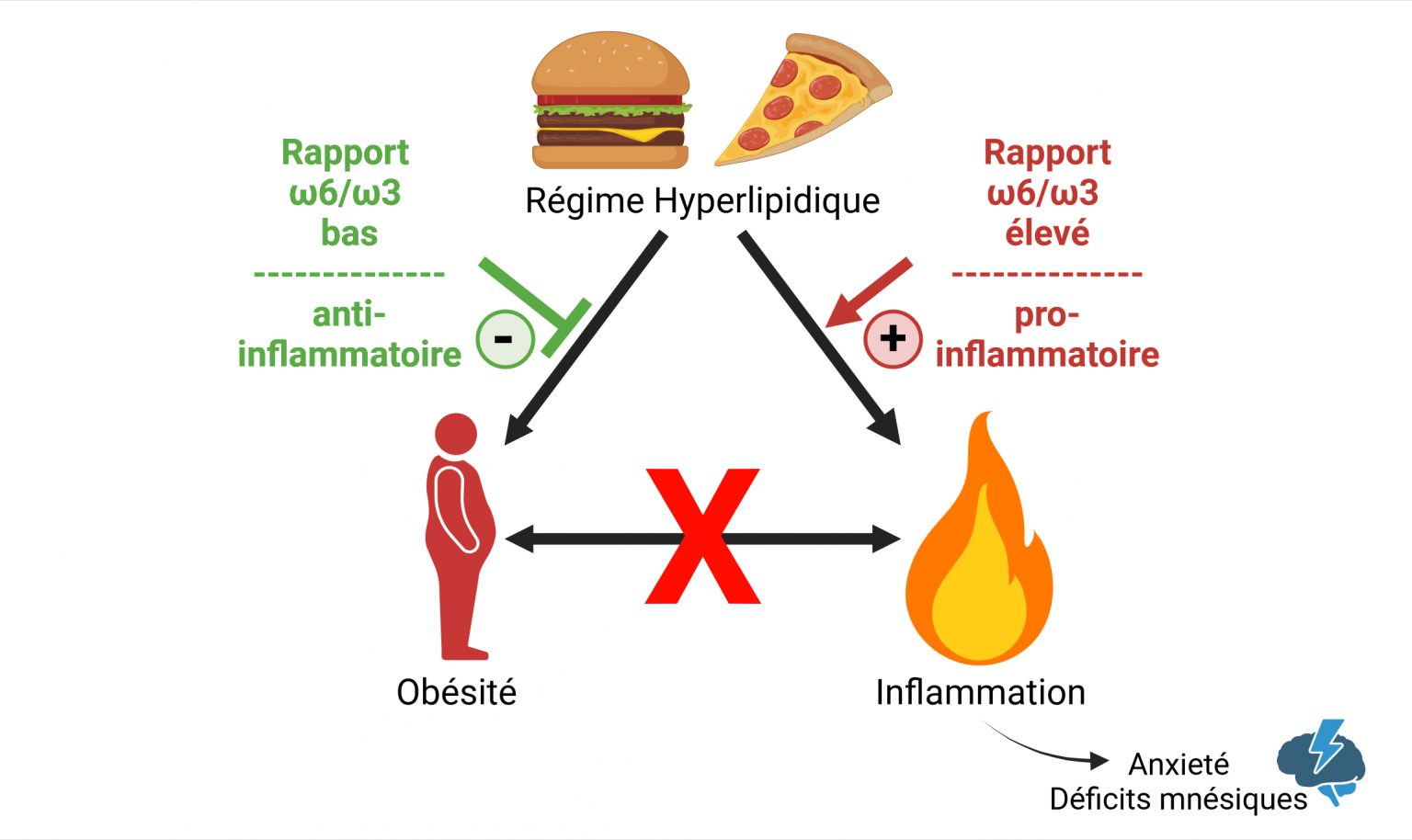Obesity: opt for omega-3s to prevent the risks associated with the disease
- Research
on the February 23, 2024

In a new study published in February 2024 in Brain, Behavior and Immunity, researchers from Université Côte d'Azur, Inserm and CNRS sought to understand more precisely how diet could lead to obesity, as well as the comorbidities associated with it.
In a new study published in February 2024 in Brain, Behavior and Immunity, researchers looked more specifically at omegaga 6 (ω6) and omega 3 (ω3) fatty acids, exploring the health effects of various diets with varying fatty acid ratios (see box below). Their results indicate that a diet enriched in ω6 (in this case, sunflower oil) is strongly associated with alterations in metabolism, inflammation and cognitive functions, while a diet enriched in ω3 (in this case, rapeseed oil) has certain preventive effects. This work points to the possibility of dietary interventions based on a low ω6/ω3 ratio (i.e. preferring rapeseed oil to sunflower oil) to combat obesity and the neurological disorders associated with it.
Numerous co-morbidities associated with obesity
According to the WHO, the number of cases of obesity has almost tripled worldwide since 1975. Obesity is associated with numerous co-morbidities (type 2 diabetes, cardiovascular disease, osteoarthritis, cancer and cognitive disorders) and high mortality. Its causes are complex, involving the interaction of several factors. An unbalanced diet is nevertheless recognized as the major contributing factor to the disease.Furthermore, previous studies2 have shown that obesity is associated not only with metabolic dysfunction, but also with chronic inflammation in peripheral organs (adipose tissue, liver, skeletal muscle and pancreas), as well as in the central nervous system (referred to as neuroinflammation). This neuroinflammation in obesity is characterized by an increase in pro-inflammatory markers in the hypothalamus region, a brain area known to control eating behavior3. However, the nature of the nutritional lipids that may be responsible for this neuroinflammation has yet to be elucidated.
In a new study, researchers at the Institute of Molecular and Cellular Pharmacology have focused specifically on certain fatty acids that are essential to the proper functioning of our bodies, and are known to have anti- and pro-inflammatory properties: omegas 3 and 6 (see box below). Their aim: to better understand whether, in the context of a lipid-rich diet (known as an "obesogenic diet"), these omegas 3 and 6 are involved in the phenomenon of neuroinflammation.s in neuroinflammation, and whether they may be associated with the development of obesity.
Their work also takes as its starting point the growing trend in developed countries towards excessive consumption of omega-6s, whose inflammatory properties are well documented in the scientific literature4.
Omega 3 and omega 6: the importance of fatty acid balance
Omega-3s and omega-6s are essential fatty acids for the proper functioning of our bodies, which are unable to produce or synthesize them on their own. They must therefore be provided by the diet, but their consumption must respect a certain balance (known as the omega 6/omega 3 ratio), in order to combine the pro-inflammatory properties of omega 6 with the anti-inflammatory properties of omega 3.
- omega-6 fatty acids: for example, linoleic and gamma-linolenic acids are found in many oils such as sunflower and corn oil;
- omega-3 fatty acids: eicosapentaenoic and docosahexaenoic acids, for example, are found in oily fish, while alpha-linolenic acid is found in oils such as linseed, hemp, rapeseed, walnut and soybean.
In animal models, the scientists evaluated the health effects of three obesogenic - lipid-rich - diets, each with a different fatty acid ratio.
To compose these specific diets, the researchers used commercially available vegetable oils, namely rapeseed oil (rich in omega 3) and sunflower oil (rich in omega 6). One contained a high ratio of omega-6 to omega-3 fatty acids, i.e., highly enriched in omega-6 and therefore in sunflower oil. The second had an intermediate ratio, balanced in omega 3 and omega 6; the last was highly enriched in omega 3, and therefore in rapeseed oil.
Through various tests, they were able to measure the varying effects of these diets on weight gain and fat storage, the response to carbohydrate homeostasis5 , the development of anxiety and cognitive disorders, as well as brain inflammation.
At the end of the experiment, which lasted up to 5 months, the scientists were able to observe (results summarized in the diagram below):
- an alteration in metabolism, neuroinflammation and cognitive functions, notably an increase in anxiety and spatial memory disorders in obese mice fed a diet enriched with omega-6, and therefore with sunflower oil;
- a protective effect of the omega-3 enriched diet, rich in rapeseed oil, on weight gain, regulation of carbohydrate homeostasis and the development of cognitive disorders.

"While obesity was previously attributed with increasing inflammatory state, in this study we show that inflammatory state depends on the type of diet to which the animal is exposed. In other words, being fed a diet rich in omega-6 is responsible for the inflammatory phenomena observed, not obesity.and not obesity itself", explains Clara Sanchez, a post-doctoral researcher at Inserm and first author of the article.
"This study also shows, for the first time, the protective effect of a lipid-enriched diet against obesity and associated inflammatory phenomena, provided that consumption of omega-3 fatty acids is increased. This work opens up the possibility of dietary interventions based on a low ω6/ω3 ratio to combat obesity and the neurological disorders associated with it", explains Carole Rovère, the Inserm researcher who last authored the article.
In their discovery, the scientists also observed in these mice a change in the shape of certain brain cells located in the hypothalamus, known as microglia, which seem to become activated in response to a diet rich in omega 6. Their work will now focus on better understanding the specific role of these cells in obesity.
1OMS, 2016
2Gregorand Hotamisligil, 2011; Thaler et al., 2012
3 Baufeld et al., 2016; Cansell et al., 2021; De Souza et al., 2005; Le Thuc and Rovère, 2016; Salvi et al., 2022
4 The WHO recommends consuming five omega-6s for every omega-3. Yet in Western societies, this ratio is exploding - it is said to be 3 times higher than the current omega-6 recommendations.
5Carbohydratehomeostasis is a state of equilibrium between glucose intake (intestinal absorption following a meal or glucose production by the liver) and utilization (glucose input and utilization in the organs).
- Sources
-
Dietary fatty acid composition drives neuroinflammation and impaired behavior in obesity
Clara Sanchez1, Cécilia Colson1,2, Nadine Gautier2, Pascal Noser3, Juliette Salvi4, Maxime Villet1, Lucile Fleuriot1, Caroline Peltier4, Pascal Schlich4, Frédéric Brau1, Ariane Sharif5, Ali Altintas3, Ez-Zoubir Amri2, Jean-Louis Nahon1, Nicolas Blondeau1, Alexandre Benani4, Romain Barrès1,3 and Carole Rovère1*
1 Université Côte d'Azur, Institut de Pharmacologie Moléculaire et Cellulaire, CNRS, 7 France 8
2 Université Côte d'Azur, Institut de Biologie de Valrose, CNRS, INSERM, France 9
3 Novo Nordisk Foundation Center for Basic Metabolic Research, University of 10 Copenhagen, Denmark 11
4 Université Bourgogne Franche-Comté, Centre des Sciences du Goût et de 12 l'Alimentation, CNRS, INRAe, France 13
5 Université de Lille, CHU Lille, Laboratory of Development and Plasticity of the 14 Neuroendocrine Brain, Lille Neurosciences & Cognition, UMR-S 1172, Lille, France
Brain Behavior and Immunity, February 2, 2024
https://doi.org/10.1016/j.bbi.2024.01.216, - Research contacts
-
- Clara Sanchez - Post-doctoral researcher - UMR 7275 CNRS/Université Côte d'Azur, Institute of Molecular and Cellular Pharmacology sanchez@ipmc.cnrs.fr
- Carole Rovère - Inserm researcher - UMR 7275 CNRS/Université Côte d'Azur, Institute of Molecular and Cellular Pharmacology - carole.rovere-jovene@inserm.fr



